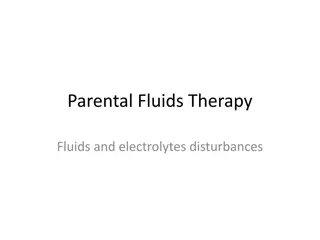Understanding Fluid Therapy in Animals: Basics and Indications
Explore the fundamental concepts of body fluids in animals, including their composition, types, routes of administration, and signs of fluid overload. Delve into the balance of intracellular and extracellular fluids, daily water intake and loss, and the role of electrolytes. Dr. Bipin Kumar provides essential insights for veterinary professionals and animal caretakers on fluid therapy in animals.
Download Presentation

Please find below an Image/Link to download the presentation.
The content on the website is provided AS IS for your information and personal use only. It may not be sold, licensed, or shared on other websites without obtaining consent from the author. Download presentation by click this link. If you encounter any issues during the download, it is possible that the publisher has removed the file from their server.
E N D
Presentation Transcript
Fluid therapy in animals Dr. Bipin Kumar, Assistant Professor Department of Veterinary Medicine Bihar Veterinary College, Patna (Bihar Animal Sciences University, Patna)
Body Fluid overview; Basics of body fluids and its composition. Water balance in body. Regulation of body fluids. Fluid therapy &its indication. Types of fluids. Routes of administration. Fluid over load signs.
Basics of Body Fluid: An adult animal contains about 60% fluid of its body weight. Intracellular fluid (ICF) consists of about two-thirds of total body fluids. The extracellular fluid (ECF) which constitutes about one- third of the total body fluids. It is divided into three sub compartments interstitial, intravascular, and trans cellular. The interstitial contains three-quarters of all the fluid in the extracellular space. The intravascular contains the fluid, mostly plasma, that is within the blood vessels. Total blood volume is roughly 8% of bodyweight and plasma roughly 5% of bodyweight
The fluid in the transcellular compartment is produced by specialized cells responsible gastrointestinal fluid, bile, glandular secretions, respiratory sections, and synovial fluids. Daily water intake is about 10% of the body weight (can vary from animal to animal with respect of their age, environment, feed intake etc. ). Daily water loss equals daily intake and this loss occurs through the skin, lung, kidney and gastrointestinal tract. for cerebrospinal fluid,
Body water contains solutes (substances that dissolve in solvent; particles). Electrolytes are substances that split into ions when placed in water. Primary ions in the body are sodium, potassium, chloride, phosphate, and bicarbonate. Cations are positively charged ions. Anions are negatively charged ions. Body water is the solvent in biological systems To establish equilibrium, body water moves along its concentration gradient
Fluid therapy Types: Replacement therapy: Therapy in which we infuse same type of fluid which is lost from body Adjunctive Therapy: One type of fluid is given to remove other type of fluid e.g. mannitol 25% is given in case of ascites and edema. Supportive Therapy: Fluid is given to animal just to support him to cure quickly i.e. amino acids, minerals, multivitamins and carbohydrates etc.
Indications: Fluids are administered to patients not only to replace fluid loss but also to correct electrolyte abnormalities, promote kidney diuresis, and maintain the tissue or organ perfusion. During shock. Dehydration. Diuresis (Toxicities , renal diseases). After surgical procedure i.e. to prevent hypotension as hypotension may be due cardiovascular function etc. Acid base abnormalities. Electrolyte abnormalities. to vasodilation, decreased
Dehydration: Dehydration or the loss of fluid from the interstitial space in the form of increased fluid loss from vomiting, diarrhea, or polyuria is one of the main cause of water reduction in body. Signs include decreased skin tenting, sunken eyes, depressed mentation, and tacky/dry mucous membranes, CRT 2-3 sec in mild cases and >3 sec in severe cases, Slight depression of eyes into sockets.
Diagnosis of Dehydration: Physical exam Weight loss PCV (HCT) increased Albumin or total protein increased BUN, creatinine Prerenal azotemia
Degreeof dehydration(%) Clinical signs <5 Not clinically detectable. 5-6 Subtle-loss of skin elasticity 6-8 Obvious delay in return of tented skin. Slightly CRT Possible sunken & dry mucous membrane of eye 10-12 Skin remain tented. Very prolonged CRT. Sunken eyes & dry mucous membranes. Possibly signs of shock (tachycardia, cool extremities, rapid & weak pulse) 12-15 Obvious signs of shock. Death imminent
Clinical signs Hypovolaemicand cardiogenicshock Vasodilatory shock Heart rate Tachycardia and end stage bradycardia Tachycardia Pulse rate Weak becoming absent Bounding Mucus membrane Pale Bright red (hyperemic) Capillary refill timeCRT Prolonged Rapid Blood pressure May initially be normal due to sympathetic response then decline Low Temperature of extremities Cool Warm
Types of fluid: (a) Crystalloids. Contain sodium as the main osmotically active particle. Useful for volume expansion (mainly interstitial space). For maintenance infusion. Correction of electrolyte abnormality. Types of crystalloids Isotonic crystalloids Lactated Ringer s, 0.9%NaCl(Normosol) Only 25% remain intravascularly
Hypertonic saline solutions 3% NaCl, 0.9% normal saline with 5% dextrose &10% dextrose in water Hypotonic solutions D5W(dextrose 5 % in water) 0.45% NaCl 0.25% NaCl Less than 10% remain intravascularly, inadequate for fluid resuscitation.
Lactated Ringers Solution: Composition closely resembles ECF Contains physiological concentrations of: sodium, chloride, potassium, and calcium Also contains lactate, which is metabolized by the liver alkaline- forming Because small animals that are sick or under anesthesia tend towards acidosis
Ringers Solution: Same as LRS except no lactate added Commonly used in Large animals Large animals who are sick tend towards alkalosis instead of acidosis Normal Saline: 0.9% Sodium chloride = ISOTONIC Lacking in K+, Ca2+ Used for hyperkalemia, hypercalcemia Used as a carrier for some drugs Used if don t want lactate
(b) Colloids Contain high molecular weight substances which do not readily migrate across capillary walls Preparations -Albumin: 5%, 25% - Dextran - Gelifundol - Haes-steril 10% Natural Colloids Blood products: Whole blood Plasma Platelet-rich plasma Packed RBC s
Synthetic Colloids; Dextrans, Hetastarch Used when quantity of a crystalloid is too great to be able to infuse quickly Stays within the vasculature maintain blood pressure Duration of effect is determined by molecular size: bigger = longer Small volumes produce immediate increases in blood pressure
Routes of administration Advantage Disadvantage Oral Safe &Easy Less rapid absorption Possible aspiration Cannot use for vomiting animals Routes of administration: Subcutaneous Relatively easy to administer Absorption distributed over time Possible infection Must use isotonic fluids Slower absorption Intravenous Precise amount given is available rapidly Various tonicities of fluid can be used Possible fluid overload and vessel damage Requires close monitoring Must be sterile Intraperitoneal Relatively rapid absorption Can be used when IV access is not available Possible infection Cannot use hypertonic solutions
Intraosseous Useful for small animals, birds, and pocket pets Can be used when vein inaccessible Rapid absorption Lack of confidence in administering fluid via this route Possible infection Rectally Good absorption Not frequently used
Fluids: How Much to Give? Correct dehydration Weight in kg times percent dehydration equals the amount in litres that the animal is dehydrated Example: 100 kg animal who is 8% dehydrated 100kg X 0.08 = 8 liters Patient is lacking 8 liters, or 8000 ml fluids
So How Is It Delivered? Infusion pump (easy) IV drip set: drops per ml written on package Regular Drip sets have 10, 15, or 20 drops per ml -- Med & large dogs Micro drip sets have 60 drops per ml --Small dogs & cats
Calculate Drops Per Hour Calculate ml/hr. Calculate drops/hr by: ml/hr X drops/ml (from the package) Gives you drops needed in an hour Example: 100 ml X 10 drops per ml = 1000 drops in the first hour
Calculate Drops Per Minute Divide drops per hour by 60 min/hr to get drops per minute Ex: 1000 drops/ hr divided by 60 minutes per hour = 16.7 drops per minute 16.7 drops/min divided by 60 sec per min = 0.28 drops/sec
Principles of Rehydration: Correct dehydration, electrolyte, and acid-base abnormalities prior to surgery Do not attempt to replace chronic fluid losses all at once Severe dilution of plasma proteins, blood cells and electrolytes may result Aim for 80% rehydration within 24 hours Monitor pulmonary, renal and cardiac function closely
For example. An adult 18kg cat with 6% dehydration comes into the clinic. It is estimated that the cat vomited 150 ml of fluid overnight Maintenance fluids can be dosed at 50 ml/kg/day in adults and 110 ml/kg/day in young animals Calculate maintenance volume 18kg x 50 ml/kg/day = 900ml per day Rehydration fluid is based on the estimated percent of dehydration % dehydration x weight in kg = deficit in liters
Calculate replacement for dehydration 6% = 0.06 0.06 x 18 kg = 1.08 l 1.08 l x 1,000 ml/l = 1080 ml 1080ml x 0.8 (80% of dehydration value replaced in 24 hours) =840 ml to replace on first day Take estimated volume lost in fluid and add to the other volumes Final step: Take all values and add together 900ml + 840 ml + 150 ml = 1890ml
Fluid overload: Serous nasal discharge Increased respiratory rate (Dyspnea) Crackles or muffled lung sounds on pulmonary auscultation Late stage consequence = pulmonary edema (or pleural effusion in cats) Decreased PCV Increased BP























